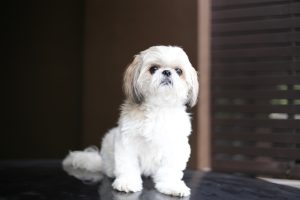Shih Tzu
Breed description
With its history reaching back to Tibet over a thousand years ago, the Shih Tzu appears to have become a timeless breed. It has enjoyed popularity within the Chinese royal dynasties, and it even survived being almost wiped out from China in the early 20th Century. These compact dogs have big dog personalities, lovable natures and a glorious, long coat, all probably reasons contributing to why they remain popular family pets today.
Pros
- Loveable dogs who enjoy human attention
- Quirky and playful nature
- Don’t require a lot of exercise
Cons
- Can be hard to discipline
- A lot of coat care is needed
- Prone to some health problems
Suitable for
The Shih Tzu is an ideal companion for families, couples or individuals who don’t have a lot of outdoor space. Given their love of curling up on your knee or beside you on the sofa, they’re also suitable pets for apartment living – although they may bark, something to take into consideration for those with close neighbours. They tend to do well with other dogs and children, but, as always, each is an individual and proper socialisation from being a puppy is key to developing a tolerant and confident dog.
- Families with children
- Less active homes
- Housing environments with no, or limited, outdoor space
This wonderful breed could make an ideal pet for a retired couple with only a small garden, looking for a joyful and entertaining lapdog to pass the time with and enjoy some gentle walks.
Breed care advice
The typical, long, flowing and sleek coat of a show ring Shih Tzu is no easy feat to maintain. Proper coat care to maintain a clean and neat coat requires careful, daily combing and attention to long hairs around the face that can easily overhang the eyes. Many owners opt to tie up these hairs into a bobble on top of the head (but it’s important to ensure this isn’t done tightly), or to trim the hairs neatly around the face. Equally, the coat can be easier managed when clipped, helping to avoid it becoming overly dirty and reducing the amount of dedicated grooming attention that’s needed. They can be an opinionated and disobedient breed if not trained well enough from puppies, so lots of perseverance and positive reinforcement are needed to help them build good habits and behaviour, in order that things such as coat brushing, clipping and nail trims become easy tasks that don’t cause undue stress.
Shih Tzus don’t need a lot of exercise, but they do benefit from at least half an hour of walking each day. In the house, they are more than happy to continue their activity with a good dose of playtime. However, these dogs should avoid becoming overheated in warmer months, to help prevent unwanted problems like heat stroke from developing. This means not walking unless it’s in the cooler early morning or evening hours, allowing access to plenty of water and providing them with a cool place to lie.
Known health problems
The Shih Tzu breed is known to be at risk of a number of disease processes. Of course, no individual is guaranteed to have any one or more of these problems, however the breed as a whole shows a tendency to develop them. For example, such small breed dogs often suffer from tracheal collapse, this is where the cartilage structure of the windpipe (trachea) is weak, allowing the tube to collapse inwards and cause breathing difficulty. Tracheal collapse can be mild to very severe, and the Shih Tzu may suffer secondary problems such as dilation of the lower airways (bronchiectasis) and lower airway disease, on top.
The anatomy of many Shih Tzus mean that the structure of the knee isn’t as good as it should be, often because of the shape of the femur bone, problems during growth or an abnormally shaped kneecap (patella) or groove where the kneecap sits. These can result in a condition known as patella luxation, where the kneecap can slide out of position. In some dogs it’s very mild and doesn’t cause a problem, it can sometimes be recognised by a skipping gait in the hindlegs when the dog is moving. Mild cases need no specific treatment, but maintaining them in good physical shape and keeping them well-muscled, is advisable. However, some dogs with patella luxation can suffer instability, lameness and often arthritis with age, corrective surgeries may be considered for these dogs, in order to improve the function and position of the kneecap, however, they will not halt the progression of arthritis.
- Tracheal collapse and bronchiectasis
- Patella luxation
- Canine allergic disease – allergic disease including skin disease is recognised in Shih Tzus
- Anal sac disease – this can form a part of allergic disease, but may reflect other causes of irritation or infection in the anal sacs, leading to discomfort and sometimes abscessation. Some dogs will suffer from repeated episodes
- Eye problems – Shih Tzus are at risk genetically from glaucoma (high pressure in the eye which can cause blindness), whilst anatomically, the often-bulging nature of the eyes can lead to overexposure and cause drying and ulceration of the eye surface (cornea)
- Urinary stones – the breed has a tendency to form calcium oxalate stones in the urinary tract, these can be problematic (sometimes causing kidney obstruction or bladder irritation), and often need to be removed surgically.
Lead author: Yvette Bell MRCVS
